

Ontology-Based Applications for Enterprise Systems and Knowledge Management: 9781466619937: Library and Information Science Books. On The Fly RDF converter · dbcls/bh14 Wiki. Develop an On The Fly RDF converter to expose files, RDBMS or noSQL databases as SPARQL endpoints.
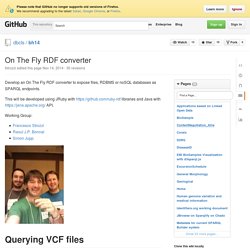
This will be developed using JRuby with libraries and Java with API. Working Group: Querying VCF files. The Ultimate Guide to .htaccess Files. Apache's .htaccess configuration files have baffled countless developers.
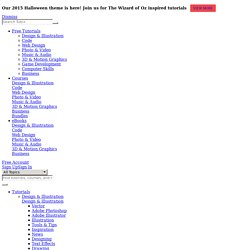
This tutorial aims to break through this confusion by focusing on examples and thorough descriptions. Among the benefits of learning .htaccess configuration is automatic gzipping of your content, providing friendlier URLs, preventing hotlinking, improving caching, and more. Best Practice Recipes for Publishing RDF Vocabularies. W3C Working Group Note 28 August 2008 This version: Latest version: Previous version: Editors: Diego Berrueta, Fundación CTIC Jon Phipps, Cornell University Library Previous Editors: Alistair Miles, STFC Rutherford Appleton Laboratory Thomas Baker, Goettingen State and University Library.

.htaccess - subdomains linked to different files using htaccess. Linked DataFCNS. I have recently joined the Computer Science department of TELECOM SudParis as an intern.
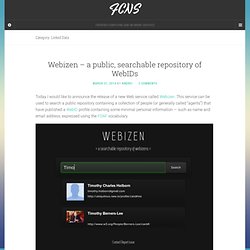
My job is to integrate Triplify and Bugzilla in order to create semantic data. In other words, I have to export data from the Bugzilla database to an RDF file. All this is possible due to Triplify, a php script that can be configured to query given tables from a specified database. The main part is the definition of a number of SQL queries selecting information that is meant for public use. In order for Triplify to be able to convert the results of your SQL queries into RDF, the query results are required to have a certain structure.
This is the classmap for the database tables queried by Triplify (class->table): Quick and dirty linked data content negotiation. I've managed to fill a key gap in the world's supply of Linked Open Data by publishing triples that connect Mad Magazine film parody titles to the DBpedia URIs of the actual films.

Debugging Semantic Web sites with cURL. Here at our group we spend a lot of time preaching the benefits of dereferenceable URIs. We often want to know if a certain URI supports all the fancy HTTP tricks that are the cornerstones of RDF publishing best practices, like 303 redirects and content negotiation. My tool of choice for this is cURL, a command-line HTTP client that makes a useful addition to any Semantic Web developer’s toolbox. This tutorial shows how to use cURL to test Semantic Web URIs and to diagnose some common problems.
Getting cURL: Windows users can get cURL binaries from here, the first “non-SSL binary” version will work. Find curl.exe in the archive and drop it somewhere on the path, e.g. in C:\Windows. To test cURL, open a command prompt and invoke. SPARQL 1.1 Query Language. This section defines the correct behavior for evaluation of graph patterns and solution modifiers, given a query string and an RDF dataset.
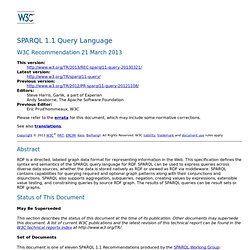
It does not imply a SPARQL implementation must use the process defined here. The outcome of executing a SPARQL query is defined by a series of steps, starting from the SPARQL query as a string, turning that string into an abstract syntax form, then turning the abstract syntax into a SPARQL abstract query comprising operators from the SPARQL algebra.
This abstract query is then evaluated on an RDF dataset. 18.2 Translation to the SPARQL Algebra This section defines the process of converting graph patterns and solution modifiers in a SPARQL query string into a SPARQL algebra expression. The SPARQL query string is parsed and the abbreviations for IRIs and triple patterns given in section 4 are applied. The result of converting such an abstract syntax tree is a SPARQL query that uses the following symbols in the SPARQL algebra: Php - group_concat with ARC2. Rrdf 2.0: Updates, some fixes, and a preprint. Rdfquery.jron.js - shuffl - Supporting curation of small-scale research data for web publication. 03-DavidBooth-rdf-as-universal. New Linked Data service launches. We are delighted to launch the next iteration of our Linked Data service today at: In preparation for this launch we created a beta version, which was designed for you to have a play around, test, and review against your current applications.
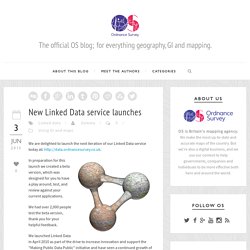
We had over 2,000 people test the beta version, thank you for your helpful feedback. Graffoo - Graphical Framework for OWL Ontologies. Graffoo, a Graphical Framework for OWL Ontologies. Graffoo, a Graphical Framework for OWL Ontologies [1], is a wonderful new open source tool developed by Silvio Peroni that can be used to present the classes, properties and restrictions within OWL ontologies, or sub-sections of them, as clear and easy-to-understand diagrams.
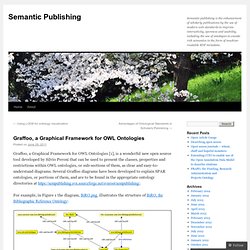
Several Graffoo diagrams have been developed to explain SPAR ontologies, or portions of them, and are to be found in the appropriate ontology directories at For example, in Figure 1 the diagram, BiRO.png, illustrates the structure of BiRO, the Bibliographic Reference Ontology: Graffoo diagram of BiRO, the Bibliographic Reference Ontology The lower part of the diagram shows how such a bibliographic record can be realized (i.e. expressed in a specific form, forming what in FRBR terminology is an Expression) as a bibliographic reference, such as you might find in an article’s reference list.